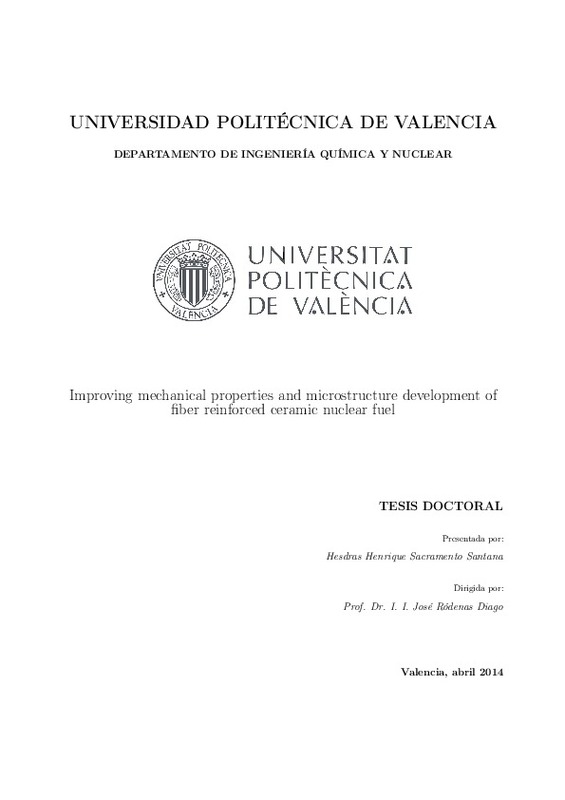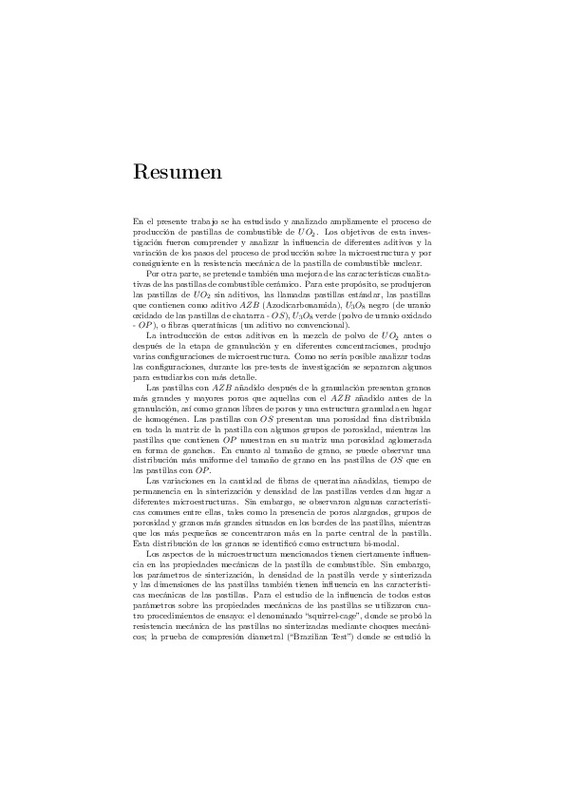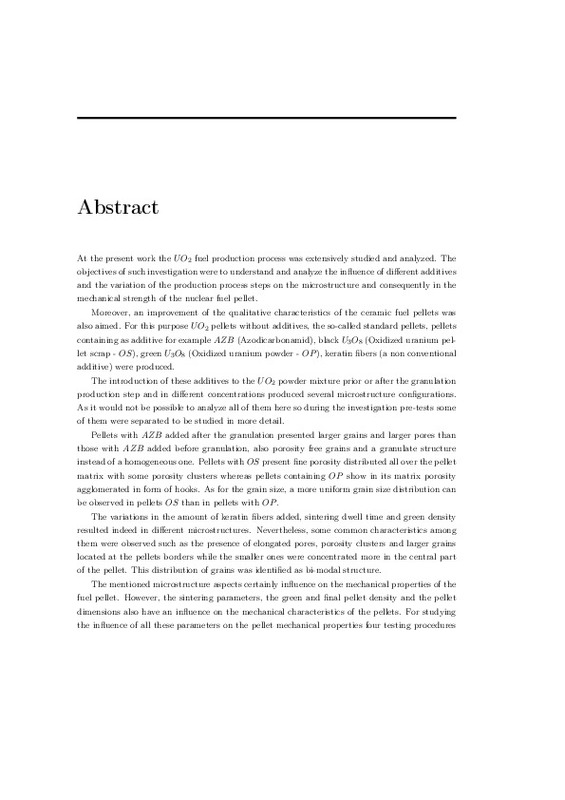|
Resumen:
|
At the present work the UO2 fuel production process was extensively studied and analyzed. The
objectives of such investigation were to understand and analyze the influence of different additives
and the variation of the ...[+]
At the present work the UO2 fuel production process was extensively studied and analyzed. The
objectives of such investigation were to understand and analyze the influence of different additives
and the variation of the production process steps on the microstructure and consequently in the
mechanical strength of the nuclear fuel pellet.
Moreover, an improvement of the qualitative characteristics of the ceramic fuel pellets was
also aimed. For this purpose UO2 pellets without additives, the so-called standard pellets, pellets
containing as additive for example AZB (Azodicarbonamid), black U3O8 (Oxidized uranium pellet
scrap - OS), green U3O8 (Oxidized uranium powder - OP), keratin fibers (a non conventional
additive) were produced.
The introduction of these additives to the UO2 powder mixture prior or after the granulation
production step and in different concentrations produced several microstructure configurations.
As it would not be possible to analyze all of them here so during the investigation pre-tests some
of them were separated to be studied in more detail.
Pellets with AZB added after the granulation presented larger grains and larger pores than
those with AZB added before granulation, also porosity free grains and a granulate structure
instead of a homogeneous one. Pellets with OS present fine porosity distributed all over the pellet
matrix with some porosity clusters whereas pellets containing OP show in its matrix porosity
agglomerated in form of hooks. As for the grain size, a more uniform grain size distribution can
be observed in pellets OS than in pellets with OP.
The variations in the amount of keratin fibers added, sintering dwell time and green density
resulted indeed in different microstructures. Nevertheless, some common characteristics among
them were observed such as the presence of elongated pores, porosity clusters and larger grains
located at the pellets borders while the smaller ones were concentrated more in the central part
of the pellet. This distribution of grains was identified as bi-modal structure.
The mentioned microstructure aspects certainly influence on the mechanical properties of the
fuel pellet. However, the sintering parameters, the green and final pellet density and the pellet
dimensions also have an influence on the mechanical characteristics of the pellets. For studying
the influence of all these parameters on the pellet mechanical properties four testing procedures were utilized the so-called squirrel-cage where the mechanical resistance of the not sintered pellets
against mechanical shocks was tested, the diametrical compression test (Brazilian Test) where
the strength of sintered and not sintered pellets was studied, the Vickers indentation technique
and the creep test where the pellet plasticity respectively at room and at elevated temperatures
was analyzed.
The squirrel-cage results showed that the pellets with keratin fibers were much more mechanically
resistant than those pellets without it, which means that the keratin fibers acted, prior
sintering, as a powder binder increasing the cohesion among the powder granules proportionating
the green pellets higher mechanical resistance against impacts.
The Brazilian test evaluated the influence of the pellet length to the pellet diameter (L/D
ratio), the influence of different additives mixed to the UO2 powder and the different pellet
production processes. The L/D influence analysis showed that if one fixes the pellet diameter
and increase the pellet length the Weibull modulus (here a measure of the pellet lot reliability)
will also increase. By comparing pellets with OS, OP and 0.3% keratin fibers it was observed
that pellets with OS presented the highest volume of pores smaller than 10 mm while pellets with
OP and keratin presented the highest volume of pores larger than 20 mm. It seems that this
relevant characteristic favored to the highest Weibull strength value for pellets with OS.
In the indentation test standard pellets, pellets with OS and pellets with keratin fibers were
tested. The results showed that the calculated hardness for the standard pellets is slightly lower
when compared to the values obtained by the pellets with keratin fibers. Also the pellets containing
OS when compared to the keratin fibers pellets have in most of the cases a lower hardness. The
calculated fracture toughness and fracture surface energy values show also a better mechanical
behavior for the keratin fibre pellets than in the standard pellets.
Standard pellets, pellets with 30%OP, which had the smallest grain size, pellets with keratin
fibers, having the bi-modal structure and pellets with chromium oxide, which had the largest
grain size, were tested in the creep furnace. The results showed that all pellets with additives
presented a better creep behavior than the standard pellets. Among the pellets prepared with
additives the comparison clearly showed that under lower stresses pellets with smaller grains have
a better creep rate. By increasing the applied stresses we observe an improvement of the creep
rate of the pellets with chromium oxide and keratin fibre even slightly overcoming the pellets
with 30%OP at the highest applied stress.
[-]
|













